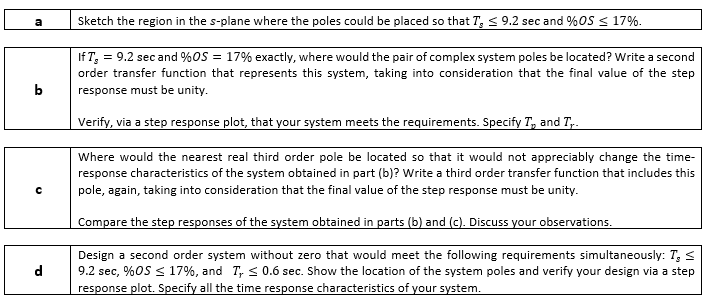Sketch the region in the s-plane where the poles could be placed so that T, < 9.2 sec and %OS s 17%. If T, = 9.2 sec and %OS = 17% exactly, where would the pair of complex system poles be located? Write a second order transfer function that represents this system, taking into consideration that the final value of the step response must be unity. b Verify, via a step response plot, that your system meets the requirements. Specify T, and T,. Where would the nearest real third order pole be located so that it would not appreciably change the time- response characteristics of the system obtained in part (b)? Write a third order transfer function that includes this pole, again, taking into consideration that the final value of the step response must be unity. Compare the step responses of the system obtained in parts (b) and (c). Discuss your observations. Design a second order system without zero that would meet the following requirements simultaneously: T, S 9.2 sec, %OS s 17%, and T, S 0.6 sec. Show the location of the system poles and verify your design via a step response plot. Specify all the time response characteristics of your system.
Sketch the region in the s-plane where the poles could be placed so that T, < 9.2 sec and %OS s 17%. If T, = 9.2 sec and %OS = 17% exactly, where would the pair of complex system poles be located? Write a second order transfer function that represents this system, taking into consideration that the final value of the step response must be unity. b Verify, via a step response plot, that your system meets the requirements. Specify T, and T,. Where would the nearest real third order pole be located so that it would not appreciably change the time- response characteristics of the system obtained in part (b)? Write a third order transfer function that includes this pole, again, taking into consideration that the final value of the step response must be unity. Compare the step responses of the system obtained in parts (b) and (c). Discuss your observations. Design a second order system without zero that would meet the following requirements simultaneously: T, S 9.2 sec, %OS s 17%, and T, S 0.6 sec. Show the location of the system poles and verify your design via a step response plot. Specify all the time response characteristics of your system.
Introductory Circuit Analysis (13th Edition)
13th Edition
ISBN:9780133923605
Author:Robert L. Boylestad
Publisher:Robert L. Boylestad
Chapter1: Introduction
Section: Chapter Questions
Problem 1P: Visit your local library (at school or home) and describe the extent to which it provides literature...
Related questions
Question
A certain servomechanism system has dynamics dominated by a pair of complex poles and no finite zeros. For this system, do the following.

Transcribed Image Text:Sketch the region in the s-plane where the poles could be placed so that T, < 9.2 sec and %0S < 17%.
a
If T, = 9.2 sec and %OS = 17% exactly, where would the pair of complex system poles be located? Write a second
order transfer function that represents this system, taking into consideration that the final value of the step
b
response must be unity.
Verify, via a step response plot, that your system meets the requirements. Specify T, and T,.
Where would the nearest real third order pole be located so that it would not appreciably change the time-
response characteristics of the system obtained in part (b)? Write a third order transfer function that includes this
pole, again, taking into consideration that the final value of the step response must be unity.
Compare the step responses of the system obtained in parts (b) and (c). Discuss your observations.
Design a second order system without zero that would meet the following requirements simultaneously: T, <
9.2 sec, %OS < 17%, and T, < 0.6 sec. Show the location of the system poles and verify your design via a step
response plot. Specify all the time response characteristics of your system.
го
d
Expert Solution
This question has been solved!
Explore an expertly crafted, step-by-step solution for a thorough understanding of key concepts.
This is a popular solution!
Trending now
This is a popular solution!
Step by step
Solved in 7 steps with 3 images

Knowledge Booster
Learn more about
Need a deep-dive on the concept behind this application? Look no further. Learn more about this topic, electrical-engineering and related others by exploring similar questions and additional content below.Recommended textbooks for you

Introductory Circuit Analysis (13th Edition)
Electrical Engineering
ISBN:
9780133923605
Author:
Robert L. Boylestad
Publisher:
PEARSON

Delmar's Standard Textbook Of Electricity
Electrical Engineering
ISBN:
9781337900348
Author:
Stephen L. Herman
Publisher:
Cengage Learning

Programmable Logic Controllers
Electrical Engineering
ISBN:
9780073373843
Author:
Frank D. Petruzella
Publisher:
McGraw-Hill Education

Introductory Circuit Analysis (13th Edition)
Electrical Engineering
ISBN:
9780133923605
Author:
Robert L. Boylestad
Publisher:
PEARSON

Delmar's Standard Textbook Of Electricity
Electrical Engineering
ISBN:
9781337900348
Author:
Stephen L. Herman
Publisher:
Cengage Learning

Programmable Logic Controllers
Electrical Engineering
ISBN:
9780073373843
Author:
Frank D. Petruzella
Publisher:
McGraw-Hill Education

Fundamentals of Electric Circuits
Electrical Engineering
ISBN:
9780078028229
Author:
Charles K Alexander, Matthew Sadiku
Publisher:
McGraw-Hill Education

Electric Circuits. (11th Edition)
Electrical Engineering
ISBN:
9780134746968
Author:
James W. Nilsson, Susan Riedel
Publisher:
PEARSON

Engineering Electromagnetics
Electrical Engineering
ISBN:
9780078028151
Author:
Hayt, William H. (william Hart), Jr, BUCK, John A.
Publisher:
Mcgraw-hill Education,